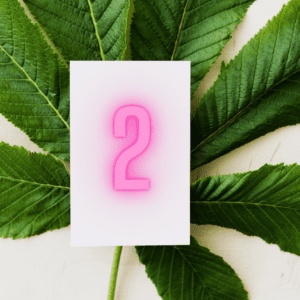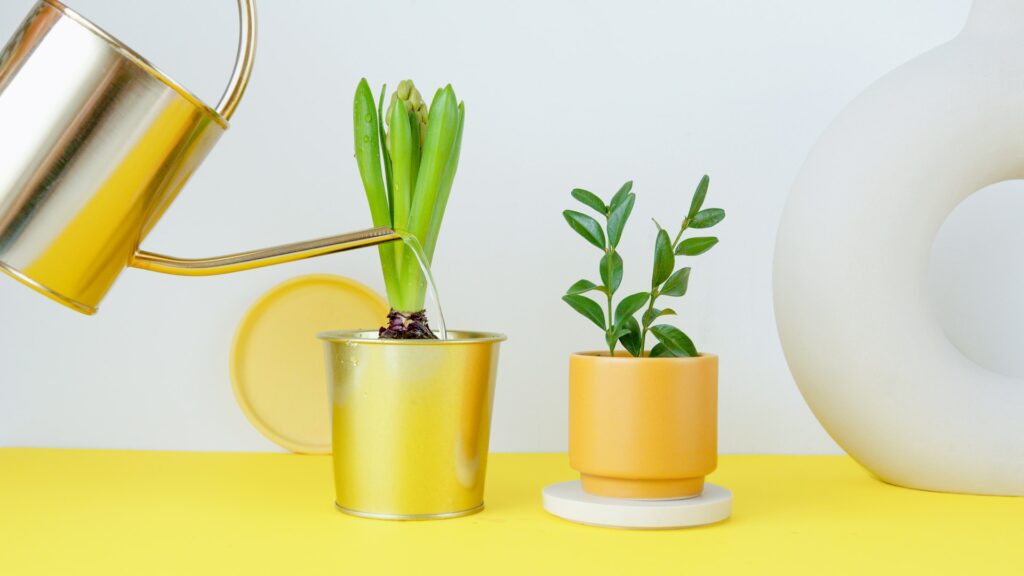In this post: I learn more about plants with benefits for physical health and mental health and also examine which plants are safe to have around pets and children.
Recently, I read the book Give a Sh*t and was inspired, among other things, to give caring for a houseplant another go. My track record to date has been fairly mixed, but I was fascinated to learn that houseplants can have a positive impact on the air quality around them. So in addition to being great sustainable home decor, they serve a positive functional benefit.
It turns out, when plants absorb carbon dioxide they can also absorb other pollutants, which can help purify the air in your home. These pollutants include things like benzene, and other VOCs which can be present in indoor air from household cleaners, carpets, furniture, and other sources.
Even better, I did a little more research and found out that the benefits of having plants in your home go beyond air purification. In addition to benefit #1 – improved air quality – these plants with benefits also have the ability to:
Studies have shown that spending time around plants can reduce stress levels and improve mood. This may be because plants help create a calming environment, and caring for them can be a relaxing activity.
There’s something about having a houseplant that feels so mindful. If you’re running around like a crazy person, it’s nearly impossible to keep a plant alive. The very act of having one (that’s alive!) feels like a mindful vote of confidence.




In addition to reducing stress, plants have been shown to benefit mental health. Studies have found that spending time around plants can improve mood, reduce anxiety and depression symptoms, and even improve cognitive function.
4. Improve sleep
Some plants, such as lavender and jasmine, are shown to have a relaxing effect that can promote better sleep. Additionally, some plants can help regulate humidity levels, which can make for a more comfortable sleeping environment.




Research has found that having plants in the workplace can improve productivity, creativity, and job satisfaction. This may be because plants help create a more pleasant and welcoming environment that is more conducive to getting comfortable and focused.
So it appears that including houseplants in your home or office design can do more than just make it look pretty. I'm proud to say my new-ish plants are still alive and I've enjoyed caring for them. I think it's too soon to say if they've improved my overall well-being or productivity but I remain hopeful.
Which indoor plants are good for health?
A few of the best plants with benefits for your health include:


Peace Lily (Spathiphyllum wallisii): Many of the plants on this list have positive impacts on a home’s air quality and Peace Lilies are one of the most studied and proven air purifiers. They’re able to remove toxins from the air and are among many plants that have a relaxing effect on the environment and can help reduce stress.


Snake Plant (Sansevieria trifasciata): In addition to air purification, it’s a really cool and unique looking addition to many different design schemes. Even better, it's easy to care for. Snake plants can tolerate low light and owners who aren’t super great at remembering to water them.


Aloe Vera (Aloe barbadensis): Aloe Vera is commonly used to treat burns (including sunburn, ack!) or other skin irritations and is also a great air purifier.


Spider Plant (Chlorophytum comosum): More air purification! Plus also they can grown in low light conditions so they’re very versatile in many different rooms and home types


English Ivy (Hedera helix): English Ivy is another plant that can help purify the air by removing toxins. In addition, it's also been shown to reduce mold in the air, making it a great plant for those with allergies or respiratory problems.
It's important to note that while plants can provide health benefits, they’re not miracle workers and should be just one part of an air quality or health improvement strategy. You’ll want to consider which indoor plants are good for health as well as other strategies depending on your particular need.
Which plants are non-toxic?
While there are some plants with benefits for the health of their owners, you definitely have to consider all of the beings in your home before you bring a new plant home. If you have small children or pets, we highly recommend that you carefully consider which plants are safe, should they be accidentally consumed.
When in doubt, do as much research as you can, teach young children not to eat or drink anything without your okay, and keep all plants out of the reach of kids and pets. I am not a plant expert but hopefully my research on non-toxic houseplants can save you some time.
The following plants were all listed by the ASPCA to be safe for dogs and cats. While there was not one great, definitive source for humans, all 9 on this list were featured on several websites as non-toxic to children. I also cross checked this list with the Children’s Hospital of Philadelphia’s list of plants that are known to be poisonous to children and none were featured there.
Based on these sources, some great non-toxic houseplants include
- Spider Plant (Chlorophytum comosum)
- African Violet (Saintpaulia)
- Christmas Cactus (Schlumbergera bridgesii) or Easter Cactus
- Boston Fern (Nephrolepis exaltata bostoniensis)
- Bamboo Palm (Chamaedorea elegans)
- Friendship Plant (Pilea involucrata)
- Parlor Palm (Chamaedorea elegans)
- Ponytail Palm (Beaucarnea recurvata)
- Moth orchid (Phalaenopsis sp.)
It's important to note that although these non-toxic houseplants are considered generally safe, some pets and humans may still have allergies or reactions to certain plants, so it's always a good idea to consult with a doctor or veterinarian if you have any concerns.
The benefits of the spider plant
After considering all of the angles of plants with health benefits, I noticed one interesting trend – the spider plant kept popping up on all of my plants with benefits lists. It seems that this humble little guy has many positive attributes including:
- Being non-toxic to humans and pets – The ASPCA and Poison Control list them as safe to keep in homes with pets and children (respectively).
- Air purification: Spider plants are known for their air-purifying properties making them great plants with benefits for the air quality of your home or office.
- Easy to care for: Spider plants are very low maintenance and can thrive in a variety of conditions. They can tolerate low light and infrequent watering, making them an ideal plant for people with a spotty track record like mine.
- Regeneration: Spider plants produce “spiderettes,” or baby spider plants, that can be grown into new plants. If you have multiple places in your home where you’d love all the benefits that a spider plant can offer, this can be a great, cost-effective way to add them.
- Versatility: Spider plants can be grown in a variety of ways in your home, including in planter pots, or hanging baskets.
It’s also just a cute plant. (Plants can be cute, right?) After learning all about this amazing plant, I went out and bought one for my desk. If everything works out, maybe I’ll even have a few little “spiderettes” in the family soon.
FAQS
Are spider plants toxic to cats?
Spider plants are considered non-toxic to cats, according to the ASPCA. This means that if your cat is a plant nibbler (aren’t they all?), it will probably be okay.
However, while spider plants are generally considered safe for pets, it's a good idea to keep any plants where they can’t get to them, as some cats may be more sensitive than others. Even if it’s fine for most cats, all pets are different and some experience digestive upset or other symptoms if they ingest any plant material.
If you suspect that your cat has ingested any part of a spider plant and is having symptoms such as vomiting, diarrhea, or lethargy, contact your veterinarian right away.
Which are the easiest non-toxic house plants?
See all of my love for the spider plant above. 🙂 The snake plant and ZZ plant are also among the easiest plants to care for but both are toxic to pets and children so be cautious if you have either and maybe consider one of the non-toxic plants on our list above.
Are there larger plants with benefits for my home?
Yes! I primarily included smaller, desk-sized plants but I came across several large indoor plants that are beautiful and also have health benefits. Here are a few plants with benefits that include air purification :
- Ficus Tree:
- Rubber Plant:
- Bird of Paradise
- Dracaena
- Parlor Palm
- Ponytail Palm
- Bamboo Palm
The sources I found only confirm the non-toxicity of the last three plants on the list (Parlor Palm, Ponytail Palm, and Bamboo Palm). If you have small children or pets, be cautious when adding a Ficus Tree, Rubber Plant, Bird of Paradise, or Dracaena to your home.
Are there large non-toxic house plants
Among the large plants, I found that the ASPCA listed as non-toxic are the Parlor Palm, Ponytail Palm, Areca Palm, and Bamboo Palm. All grow to be quite large.
Other articles you may like
Free tips and inspiration in your inbox
Enter your email address below to receive the latest news from The Home Green.




